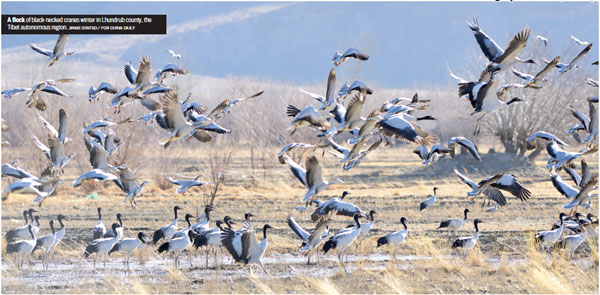On patrol to protect rare cranes

Tibetan villagers help safeguard plateau's vulnerable bird populations
Every morning, high up on the Tibetan plateau, wildlife patrolman Tanzin dons his jacket with the red armband and rides off on his motorbike to check in on black-necked cranes.
Each of the four villages he visits in the Tibet autonomous region's Lhundrub county supports between 60 to 70 of the birds, which are categorized as vulnerable by the International Union for Conservation of Nature, while the local reservoir hosts a population of about 600.
But it's not just cranes that Tanzin keeps a look out for during his patrols - he also makes careful observations of the local bar-headed goose and ruddy shelduck populations, among other birds.
"I check whether any of the birds have flown into power lines or fences and observe their movements to see if they are hurt, or are having difficulties flying or walking," he said.
"I hate the stray dogs that attack the birds around the reservoir at times. It's frustrating because they work as team and will suddenly attack from different directions. Sometimes, they even target people."
The 53-year-old said he was pleased to have been selected to be a patrolman, because he enjoys watching birds - especially the black-necked cranes.
"When they fly over, they look like magical creatures. They walk so gently and have a nobility and elegance about them when they stand," he said.
"It's easy to spot which families are which, because the males always look after the babies and the couples without nestlings are inseparable."
Being selected to become a wildlife patrolman showed the trust the local forestry bureau and villagers place in him, Tanzin said, adding that he regards the work as an extension of the compassion that his religion, Buddhism, promotes.
He treats the birds like they are his own children, even nursing an injured crane that he found in October back to health.
The bird was malnourished and in need of antibiotics, which Tanzin provided. He also encouraged his family to help prevent the local dogs from attacking it.
"For two months, my family treated the crane like it was our own child," he said.
"Whenever I hear her singing out on patrol now, I feel both happy and sad - happy because I see she is recovering, but sad because I hear sadness in her voice."

According to statistics collated by the local forest bureau over the last three years, about 1,700 black-necked cranes call Lhundrub county their wintering home - mainly spread across the townships of Jangkar, Khartse, and Tsodoi.
They forage in the fields during the daytime and spend most of their evenings by the reservoir.
Measures that have been put in place by the local government to protect the cranes are aided by the local Tibetans, who regard the birds as sacred.
In total, 12 villagers are employed by the county government as wildlife patrolmen, each paid 600 yuan ($87) per month. They also receive a week of training every year ahead of the black-necked cranes' arrival.
Wildlife experts teach the patrolmen about the living habits of the different birds they will encounter and the laws and policies relating to their protection.
Zhang Gaofeng, who has worked with the county's forestry bureau for five years, said he had never heard of any incidents of residents hunting or harming the birds during his time there.
Tashi Dorjee, head of the Tibet Forestry Department's flora and fauna office, said the black-necked crane was the only remaining species of crane in the world to inhabit plateaus.

According a survey done by the International Crane Foundation, only about 11,000 black-necked cranes are left on Earth, and more than 80 percent - about 8,000 - reside in Tibet.
They mainly spend their winters in the middle reaches of the Yarlung Zangbo River, while the wetlands around Silingtso Lake provide their breeding grounds. National-level nature reserves are being established at both locations at a cost of more than 160 million yuan ($23.1 million).
The regional forestry department said protecting and monitoring the wildlife in these wetlands could create about 72,000 jobs for rural residents - including 200 wildlife patrolmen.
"It is not enough for wildlife protection units to deal with the work of protecting the wildlife alone," Tashi Dorjee said.
"If rural residents become more involved it will not only raise their awareness of wildlife protection, but increase their family incomes as well."
Contact the writers at palden_nyima@chinadaily.com.cn









